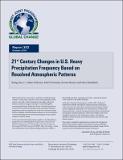21st Century Changes in U.S. Heavy Precipitation Frequency Based on Resolved Atmospheric Patterns
Author(s)
Gao, X.; Schlosser, C.A.; O'Gorman, P.; Monier, E.; Entekhabi, D.
DownloadMITJPSPGC_Rpt302.pdf (2.050Mb)
Metadata
Show full item recordAbstract
Gridded precipitation-gauge observations and global atmospheric reanalysis are combined to develop an analogue method for detecting the occurrence of heavy precipitation events based on the prevailing large-scale atmospheric conditions. Combinations of different atmospheric variables for circulation features (geopotential height and wind vector) and moisture plumes (surface specific humidity, column precipitable water, and precipitable water up to 500hPa) are examined to construct the analogue schemes for the winter (DJF) of the Pacific Coast California (PCCA) and the summer (JJA) of the Midwestern United States (MWST). The detection diagnostics of various analogue schemes are calibrated with 27-yr (1979–2005) and then validated with 9-yr (2006–2014) NASA Modern-Era Retrospective Analysis for Research and Applications (MERRA). All of the analogue schemes are found to significantly improve upon MERRA precipitation in characterizing the number and interannual variations of observed heavy precipitation events in the MWST which is one of weakest regions for MERRA summer precipitation. When evaluated with the late 20th century simulations from an ensemble of climate models participating in the Coupled Model Intercomparison Project Phase 5 (CMIP5), all analogue schemes produce model medians of heavy precipitation frequency that are more consistent with observations and have smaller inter-model discrepancies when compared with the model-based precipitation. Further, the performances of analogue schemes with vector winds are comparable to those of geopotential height, and no analogue scheme with one of three water vapor content variables is clearly superior to another. Under two radiative forcing scenarios (Representative Concentration Pathways 4.5 and 8.5), the CMIP5-based analogue schemes produce a trend in the occurrence of heavy events through the 21st century consistent with the model-based precipitation, but with smaller inter-model disparity. The strongest reduction in the disparity of the results is seen for the RCP8.5 scenario. The median trends in DJF heavy precipitation frequency for PCCA are positive, but for JJA heavy event frequency over the MWST region, the median trends are slightly negative. Overall, the presented analyses highlight the potential of the analogue as a powerful diagnostic tool for model deficiencies and its complementarity to an evaluation that considers modeled precipitation alone to assess heavy precipitation frequency. The consistency found here between projections from analogues and model precipitation increases confidence in projected heavy precipitation frequency changes in a warming climate.
Date issued
2016-10Publisher
MIT Joint Program on the Science and Policy of Global Change
Citation
Report 302
Series/Report no.
MIT Joint Program Report Series;302